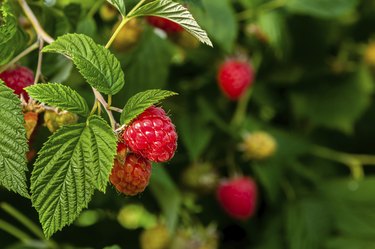
For berry growers, raspberries (Rubus idaeus) are a favorite because they will thrive in a wide range of climates, growing in U.S. Department of Agriculture plant hardiness zones 3 through 10. But if you want to know what to plant in USDA zone 9, you have a number of both summer-bearing and fall-bearing cultivars to choose from. Summer-bearing plants generally produce a large crop of berries over a one-month period in summer on one-year-old canes, while fall-bearing plants produce a large crop of berries on current season canes from mid-summer through fall.
Red Raspberries
Video of the Day
Many red raspberry cultivars will grow in zone 9. Some fall-bearing ones include "Polka," Caroline," "Autumn Bliss," "Autumn Britten," "Heritage" and "Nantahala." "Polka" comes from Poland and is known for its berries' large size, firmness and sweetness. Their sturdy, straight canes make them preferable for small spaces. "Caroline" raspberries are deep red when ripe and extremely sweet, ripening in late July to early August but require trellising due to their height. "Autumn Bliss" plants, introduced in 1984, show strong resistance to heat and bad weather but also require trellising. Their fruit is firm and sweet, making them ideal for freezing. "Autumn Britten" raspberries are slightly less tasty than "Autumn Bliss" but are usually more abundant. "Autumn Britten" is the earliest producer among the fall-bearing varieties, with berries ripened starting in mid-July. Though sturdy, they require short trellises when loaded with berries. Latest of the fall-bearing red raspberries, "Nantahala" produces fruit from the first week of September through the first frost.
Video of the Day
"Heritage" is one of the few heirloom cultivars still in production. Berries are medium to large, and their sturdy canes make them resistant to harsh weather. Summer-bearing red raspberries suited to zone 9 are "Tulameen" and "Chilliwick," the latter a thornless variety. Both produce sweet raspberries and are well-suited for coastal areas.
Yellow Raspberries
"Anne" is a variety of a fall-bearing yellow raspberry plant that grows in zone 9. This plant offers large, golden-yellow berries that grow on the tips of the canes. A tropical twist gives these berries a distinct flavor not experienced with any other raspberry. Its canes are not as sturdy as those of the red raspberry plants and require some support.
Black Raspberries
If you are a black raspberry lover living in zone 9, then you will want to try planting cultivars such as "Cumberland" or "Blackhawk." "Cumberland" is an heirloom cultivar originally found growing wild in Pennsylvania in 1890. Despite being discovered in the Northeast, it does well in more locations farther south like Texas, northern Florida and Southern California. Its wild flavor sets it apart from other black raspberry cultivars. The "Blackhawk" cultivar is also well-suited for growing in the South and Southwest. Its berries are larger than those of the "Cumberland," and it's also resistant to many diseases prevalent in humid climates.
Purple Raspberries
Have a taste for the exotic? Want to deviate from the standard red, yellow and black fare? If so, look no further than the purple raspberry. For zone 9, you will need to plant "Royalty" or "Brandywine," the purple raspberry cultivars best suited for warmer climates. They are a cross between red and black raspberries and are summer-bearing, generally producing berries in early summer. But "Royalty" berries are very sweet, while "Brandywine" berries are more tart.